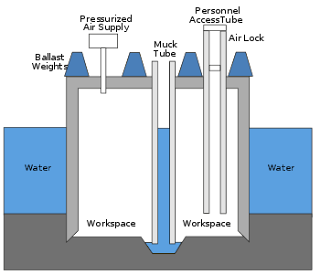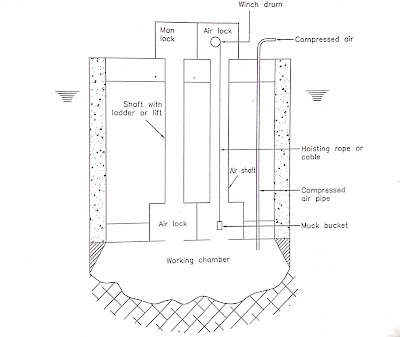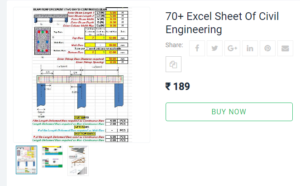What Is Pneumatic Caisson ? Working And Construction Of Pneumatic Caisson
Hello guys today we will discuss what is pneumatic caisson and how it work and how to construct.
Lets first see what is caisson ?
| caisson |
The term‘Caisson’ is derived from French word caisse meaning a box.
Caisson is defined as a watertight structure round or rectangular, which is sunk through ground or water to exclude water and semi-fluid material during the process of excavation of foundations and which subsequently becomes an integral part of the substructure.
A caisson is a relatively large deep foundation and resembles a pile foundation in transferring the load of superstructure to some desired depth.
It is mainly used for the purpose of placing deep foundations in correct position under water.
A caisson is made of reinforced cement concrete (RCC) steel or timber.
Uses of caisson
The following are the uses of caissons:
1. To reach the hard bearing strata for transferring the load of superstructure.
2. For the excavation for foundations of bridges, piers, abutments in rivers and lakes.
3. Serve as an impervious core wall of earth dams, when placed adjacent to each other.
4. To provide an access to a deep shaft or tunnel.
5. To provide an enclosure below water level for installing machinery pump, etc.
PNEUMATIC CAISSON
A pneumatic caisson is open at bottom and closed at top. This is useful at locations where it is not possible to adopt wells . They are suitable when the depth of water is more than 12 m, and maximum depth water up to 35 m .
 |
| Pneumatic caisson |
The essential feature of a pneumatic caisson is that compressed air is used to remove water from the working chamber at the bottom , and the foundation work is carried out in dry conditions .
In order that subsoil water may not enter the working chamber, the pressure of air in the chamber is kept just higher than that of water at that depth. However, the maximum pressure is limited from the considerations of health of persons who work inside the chamber.
Normally, the tolerable air pressure under which a man can work is limited to 0.35 N / mm2.
Depth of Pneumatic Caisson
The maximum depth of water up to which pneumatic caissons can be used is limited from the consideration of health of the workers.
The air pressure related to 1 m of hydrostatic head of water below the free surface of water can May be worked out from the relation:
p = wh
where,
p = Pressure in kN / m2
w = unit weight of water = 9. 81 KN / m3
h = head of water (m)
For h = 1 m
P = wh
= 9. 81 x 1 = 9. 81 KN / m2
Now the limiting pressure under which a man can work is about 343 KN / m.
Hence, the maximum depth of water up to which a pneumatic caisson can be adopted from the health view point of the workers is,
p = wh
343 = 9. 81 x h
h = 35 m
pneumatic caisson can be used for the depths of water ranging from 12 m to 35 m.
Construction Procedure of Pneumatic Caisson
 |
| Pneumatic caisson |
1.The caisson is sunk as usual through water till no trouble is encountered.
2 .When the pressure of water creates problems in working, an air lock is floated to the site of work hoisted and placed inside the caisson. The leakage of air is prevented by providing rubber packing
Generally, two air locks are used, one for men and other for removing the excavated material and for carrying concrete for providing seal at the bottom.
3. After the lock is placed in position, the water inside the caisson is pumped out and the compressed air is used to prevent the entry of water from the bottom of caisson.
4. The work of foundation is then started by sending the labourers to the working chamber. The height of the working chamber is kept about 2 m and lighting arrangement is provided.
The air pressure applied in the working chamber should be just sufficient to keep out the water and form a dry region. This region is known as “infiltration zone”.
5. The excavated material may be taken out by a muck bucket hoisted by a rope or cable.
6. In order to assist sinking, the explosives or reduction of air pressure for a short duration may be applied.
7. When a caisson has reached the desired level, a concrete seal is provided at the bottom.
8. The air locks and other equipment’s are removed and the filling of the caisson and provision of suitable cap at the top are provided.
Advantages of Pneumatic Caissons:
1. As the work can be done in dry condition, good quality control is maintained.
2. In situ soil tests are possible to determine the bearing capacity of soil,
3. The vertically of pneumatic caisson can be easily checked and controlled, as compared to open caissons.
4. Since concrete is placed in dry condition, higher strength of concrete can be obtained.
5. Excavation by blasting may be done, if found necessary.
6. For major projects, greater depths in bed rocks can be possible.
Disadvantages of Pneumatic Caissons:
1. Construction of pneumatic caissons is much more expensive as compared to open caissons,
2. Slow rate of work progress,
3. Maximum depth below water table is limited to 35 m.
4. There are chances of caisson diseases to workmen working under high pressure. (v) High degree of skill is required in sinking.
5. There are chances of fatal accidents during construction.
Pneumatic Caisson Sickness
The workers working under compressed air inside the working chamber, suffer a certain type of disease when they return to atmospheric pressure. This disease is known as caisson sickness or caisson disease.
The main symptoms of the disease are:
1) Dizziness
2) Headache
3) Pain in legs
4) Double vision
5) Trouble to speaking
When a person is subjected to compressed air, nitrogen is also absorbed along with oxygen by the tissue – fluids of the person. The oxygen is dissolved by blood, while nitrogen is kept in suspension as it is not soluble in blood.
When the pressure of air is reduced, tissue – fluids release the nitrogen content at a certain rate. If the reduction of pressure is not gradual, the nitrogen will not be able to come out in the form of gas. But it will form the bubbles in different parts of the body leading to caisson sickness. If the bubbles are blocked in joints, they will cause violent pains in joints. If they are developed in spinal cord or heart, it will result in paralysis or death respectively.
The Following Precautions Should Be Taken To Avoid The Caisson Sickness.
1) No person should work for more than one shift in a day.
2) The duration of shift should not exceed 12 hours.
3) The temperature of the working chamber should be maintained at 25 ° C.
4) The rate of compression and decompression should be properly controlled.
5) Persons with strong hearts, relatively low blood pressure and good circulation should be employed on the work.
6) The main locks should be well – ventilated.
7) A medical chamber must be provided just near the side of work.
8) Use of alcoholic drinks should be prohibited.
9) The workers should take enough meal before the shift starts and suitable refreshments should be served to them during interval between working periods.
10) The workers should be made fully conversant with the use of bells, signals, telephones etc.
11) Safety lamps may be provided in the air – locks to improve in advance the possible fire – hazard.
12) All the, passages shafts etc. of the pneumatic caissons should be maintained clear and kept properly lighted.
13) The workers use man locks for entry, interval and exit. These locks should be well – ventilated and adequately provided with suitable sanitary arrangements.
14) It is absolutely necessary to obtain the permission of the competent authority to carry out the work of pneumatic caisson. All local hospitals and police should be informed regarding the location site of work.
I Hope You Like Our Article “What Is Pneumatic Caisson ? Working And Construction Of Pneumatic Caisson” Don’t be Cheap To Share This Article with your Friends.
+READ MORE
- What Is Demolition Plan ? And How Demolition Is Carried Out Of Building Using Demolition Plan ?
- CONCRETE 3D PRINTER – Introduction , Working , Types , Applications , Advantages & Disadvantages
- Innovation in Civil Engineering “solar roadway”
- How to solve any structural beam in smartphone within 2 minute ?
- Alignment of Canals – Canal Irrigation
- 50+ CAUSES OF CONSTRUCTION PROJECT FAILURE
- How bricks are made – materials,manufacturing of bricks,moulding of bricks,burning of brick
- Plants and Equipments used in Construction Project

